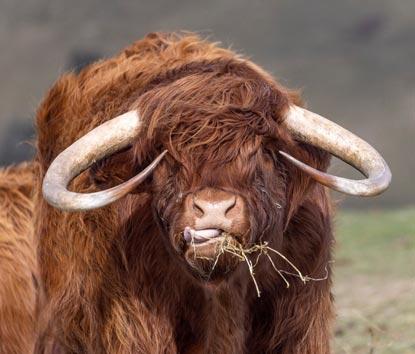
12 minute read
Agriculture
Tragedy of Gladis and her unborn
By Karen Bate
Advertisement
newsdesk@westdorsetmag.co.uk
Every morning at 11am, farmer Cameron Farquharson can be found atop Eggardon Hill, tending his herd of Highland cattle. Checking them over, feeding them and spending time with them, Cameron loves them. Cameron had a particular soft spot for Gladis, who was due to give birth on May 29 last year. And she loved this Scottish farmer and would trundle after him, nudging his hand for a digestive biscuit and a cuddle at this National Trust beauty spot. So, on May 27, when Cameron found his beloved girl lying face down a 30ft embankment with a broken neck, and her unborn calf ready to be born, both dead, he was distraught. Heartbroken. His wife Miranda said: “Cam is a big, burly Scotsman and when Gladis died, he was reduced to tears. He cried. As did my daughter, Charlotte, who was planning to take Gladis calf to the Melplash Show.” And when he learned that Gladis had been killed having been chased by two dogs, he was enraged. Posting on Facebook at the time, a post which his team carefully edited to remove the expletives, and quickly became viral, Cameron wrote: “Our beautiful highland cow called Gladys was killed when some people recklessly allowed their dogs, reportedly Labradors, to chase her to death, killing both her and her full-term unborn calf. Gladis was an amazing cow. She was beautiful, friendly, kind-hearted and was adored. She was like a member of our family. We all loved Gladis.” There is signage around this rugged but popular hilltop, urging walkers and visitors who may spot a problem with one of the livestock, to ring Cameron or the National Trust. “Had I the farmer or the National Trust been informed at the time, Gladis would not have possibly languished all night in serious injury, pain and distress and we might have been able to save her and her unborn calf.” Cameron’s Facebook post opened a tsunami of messages and support from 21.7million people. His phone rang and rang. One of those phone calls was from Stan Sadler, a generous farmer who farms in Scotland, and was devastated having read about Gladis. Stan gifted eight Highland cows and one bull to Cameron. Cameron said: “At first I didn’t believe it, but I when I spoke to Stan, he was serious. I was hammered emotionally that weekend and started to cry.” There are now 29 Highlands on Eggardon Hill. While Gladis found a special place in the hearts of all who knew her, most of Cameron’s cows are friendly, to the point that during lockdown, visitors would come far and wide to give them a stroke, a cuddle or just simply spend time in their company. “These cows are friendly despite having long horns, but they have no spatial awareness, it isn’t malice. “You might have to ballet
calf inspires bid for a change in law
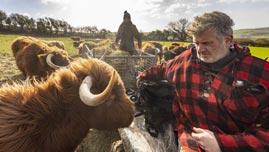
HIGHLAND FLING: Cameron and Miranda with their herd of Highland cattle at Eggardon Hill
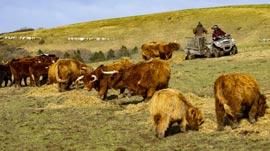
Pictures: NEIL BARNES

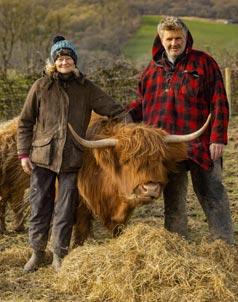
dance around them as they whip round. These native breeds are imperative for grazing Eggardon, they encourage nesting birds and rare flowering plants to thrive.” Cameron said: “Since Gladis died, I have had messages from farmers talking about their experiences of their livestock being chased by dogs, many with tragic endings. It made me realise we need a change in the law.” Cameron launched a campaign to introduce the change in law, which secured the backing of West Dorset MP Chris Loder and Farming Minister Victoria Prentis. The Gladis’ Law Campaign has driven livestock worrying to the forefront of upcoming legislation and seen extra protections for livestock included within the Animal Welfare (Kept Animals) Bill. The Bill passed its first reading in the House of Commons last summer and the campaign group hope the law will be passed in May. If passed, the law will mean dog walkers facing criminal prosecution if their dog chases any livestock to the point of causing harm or abortion, if their dogs is off their lead or out of control in a field of sheep, poultry, or enclosed game birds. Cameron added: “Livestock call their field their home and they should feel safe in their home. Gladis was chased to her death. I just pray it was quick.” n gladis-law.com
FARM FOCUSED VET PRACTICE
with Industry Leading Livestock Services
Mud-phobic Tria Stebbing lives on the outskirts of Sherborne with her farmer partner and two dogs in a converted stable. She keeps sheep, both stock sheep and pedigree rare breed sheep. She is working on her first book, in between working in a village school to pay the vet’s bills.
Some of you might have wondered about the little black lambs in my photograph last time. My partner and I have a small flock of rare breed Zwartbles sheep, Zwart-black, BlesBlaze. Zwartbles are Dutch pedigree sheep that have gained popularity in the UK in recent years and we pride ourselves on keeping the flock as true to breed standard as we can. Originating in the Friesland region of North Netherlands, it was traditionally used for both meat and milk production. A major from Cornwall was one of the first people to import them back in 1986, and in 1995 the Zwartbles Sheep Association was formed to promote the breed and maintain its purity. Fleeces should be thick with a good crimp with a black base colour, which turn chocolate brown in the sun. Blazes should be straight, of any width and run from the crown to the muzzle. Tails have a white tip that goes no more than halfway up and the white on the legs should not go above the knee. All of which is great if your stock is good. When we started the flock, we had little knowledge about what was right or wrong and where the white bits should be, consequently we have one Z that is so mis-marked she could pass as a Dutch Spotted. I have noticed that she can photobomb most of my pictures, usually standing pride of place at the front a fine example of what we are not supposed to be breeding. Yes, I succumbed, she is a pet, not a pedigree, but I feel that she to has a purpose and she is also the most affectionate of the bunch and loves her Ginger Nut biscuits. We have just scanned the flock and are expecting a lot of lambs in Easter week. Last year the mis-marked ewe had triplets, two were well marked and one was a bit random, like her. She made a great mum, and we sold the lambs to other breeders with no problem at all, so it is not always about the markings. Eight weeks to go until lambing and with multiple sets of triplets due it will be a very full on few weeks. We can only hope that this dreadful grey weather shifts to make way for warm sunshine. The Poll Dorsets, who lambed in November are about to be weaned from their mothers, they are huge for their age and are making good use of the grazing that is still available, now so big that they are hardly able to get down low enough to get to the milk. Now that’s what you call a successful lambing.
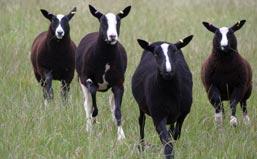
DUTCH TREAT: Some of Tria’s Zwartbles sheep I’m not losing my Zwartbles
Lots to think about if you’re lambing: Here’s your
By Emily Gascoigne of Synergy Farm Health
RCVS and European recognised specialist in small ruminant health management With many flocks lambing, it’s a good opportunity to reflect. Assisting ewes in difficulty can be both stressful and rewarding. Getting involved unnecessarily can potentially lead to its own issue. Many shepherds will have assistance during lambing. Having clear standard operating procedures, clearly communicated to the whole team can help ensure a consistent approach. A normal lambing, from water bag first appearing to lambing completion, can be two hours. When observing, the key thing we should observe for is progress. Unrewarding heaving, a gap of more than 30 minutes between scanned lambs or signs of “apparently finished lambing” without delivery such as eating whilst lambing, lack of heaving should be warning signs for examination. Examination of ewes should be done with gloved hands –evidence has identified the bacteria which cause Joint Ill in lambs in the vaginal discharges of ewes and potentially highlight risks of lambing ewes ungloved i.e. moving the bacteria across the flock. Most malpresentations should be able to be corrected relatively quickly – and as a guide- progress should have been made within 10 minutes. Clean lambing ropes, lubricants (especially powdered) and head snares are essential tools in my lambing box tool kit. For the less experienced, or if you are any doubt at any stage of lambing, please do call your vet. Top tips for correcting common malpresentations: You can never have enough lubricant – powdered lubricants are especially useful for outside lambing. Legs back – remember your anatomy and work with what you have. Legs are attached to shoulders. Shoulders are attached to the neck. The neck is attached to the other shoulder and so forth. Don’t lose your first leg – a well
The West Dorset Magazine, February 25, 2022 71 Farming Agriculture You herd it here first... with Rachel Hayball
Wobbly calfs turn into Usain Bolt... it keeps us fit!
Rachel Hayball is a married mum of six from Beaminster. She is a herdsperson and has a small flock of sheep It’s calving time. We are a spring calving herd which means that all of our cows have their calves in the spring. Calving times brings all sorts of challenges, the biggest is that the staff have to suddenly looe their Christmas-induced weight and become fit enough to become Olympic sprinters to be able to keep up with the calves. No, those cute little mooing creatures do not initially see the appeal in interacting with us human beings. I do understand. I feel the same about humans some days. Why do we need to be able to keep up with the calves? Well the main purpose is to keep them alive and out of trouble. You will often find Mum down one end of the field or yard happily eating and the calf nowhere to be seen. Sometimes we will find that calf tucked safely under a feeder or a hedge with a full belly, but at other times we will find the calf walking around shouting for its mum, or find it several fields away looking a bit confused and hungry. We need to get close to them to make sure they get that key first colostrum and dip their navels to prevent infection and make sure they get the absolute best start in life. You would think that the calf would see us and be pleased to be looked after, but no. They see us and think that we are something along the lines of the giant that persecuted Jack, and they run, and run. It’s amazing that a little newborn wobbly thing turns into an athlete in the space of a minute. They are also rather good at forgetting who their mum is. They will try to suckle anything. Another cow, a bull, a gate post, anything. If another cow comes along claiming to be their mother they will accept her without question. Even if she doesn’t have any milk. Some cows will take great offence at this, but others will be happy to be relieved of their parenting duties and will head off to get more food. Sadly yet again this year I haven’t reached Olympic sprinter standard and I certainly haven’t shifted multiple years of Christmas weight, so I am incredibly grateful that I work with someone who plays football and is more than happy to go for a run in wellies at various times of the day. Thankfully the calves soon realise that we are providers of warmth and food and once they are a few days old we look like the Pied Piper with calves following behind. Once all the calves have got to that point we can start eating cake again.
WANTED: SHEEP GRAZING Any size area considered, long or short term 07548 171553
essential guide to the dos and don’ts of the process
placed fine lambing rope can help! Head backs – using the above principle – it is in there! The use of snares can be helpful to ensure ease of guiding into the pelvis once identified. Backwards lambs – if back legs are accessed – a nice downward slope towards the ewe’s hindfeet maximises ease of delivery. Lamb resuscitators may be especially helpful in these cases where risk of inhalation of birth fluids is high. Tangled twins- pick the most “head forward” lamb and work with what you have. You may need to push the second lamb back slightly to access the first fully. Where lambing assistance is required, it is prudent to check for additional lambs either via examination with a gloved hand or through ballotment. Whilst restraining a ewe it is also an excellent time to check for milk in both halves of the udder. It is important to recognise any lambing intervention places newborn lambs at a disadvantage – lambs requiring lambing assistance have been shown to be slower to stand and suck colostrum, therefore should be a priority for colostrum feeding (whether inside or outside born) – lambs with swollen heads after a head only lambing correction are perhaps a clear example of why this may be the case, but this extends to other corrections also. Remember colostrum is gold, aim for 100ml per kg of lamb in the first six hours i.e. typically 400ml over multiple feeds. It is prudent to reflect on the ewes wellbeing at the timeimmediately after delivery she needs to “get back to work”, to mother and feed one lamb or more. A pre-lambing health visit with your vet is an opportunity to review your pain management protocol for your Health Plan. Lambing is the “best and worst of times”. Clear protocols for the team, investing time in training prior to the onset of lambing, having a clear intervention policy are prudent prior to the onset of lambing. Remember #everylambcounts Synergy Farm Health regularly runs a variety of livestock management courses, for farmers and smallholders. Our next inhouse Practical Lambing course in on March 8. Call the practice on 01935 83682. n 01935 83682 SynergyFarmHealth.com







